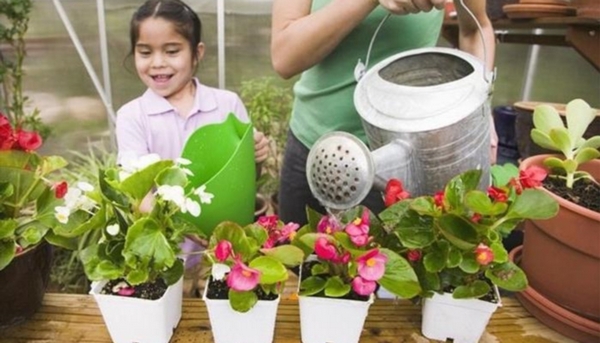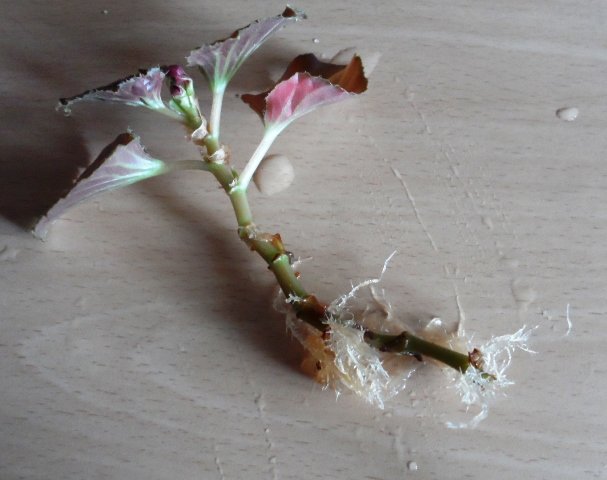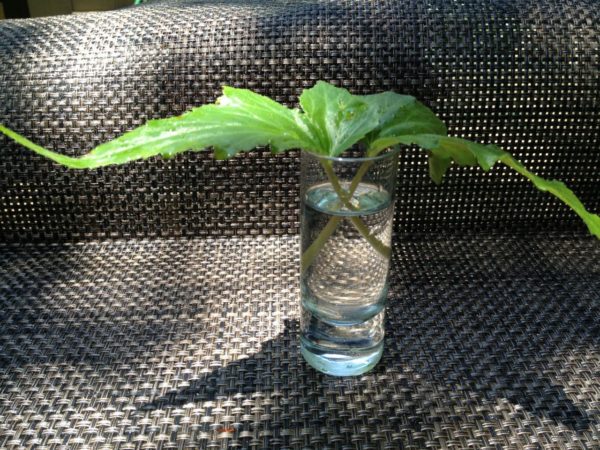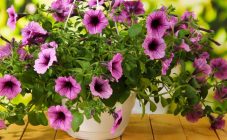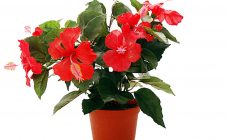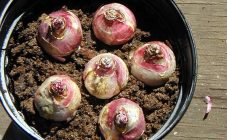Content:
Begonia is an unpretentious flower culture. Florists love it for its ease of care, decorativeness, abundant flowering. In order for begonia grown at home to successfully develop and bloom, it is necessary to create a favorable climate for it. The article will talk about how to properly care for these beautiful flowers, as well as propagate them.
Home begonias care
Site selection, lighting, humidity
Houseplant prefers persistence. You need to choose a certain place with good lighting for the begonias. At the same time, direct sunlight should not fall on it. The sills of the east or west windows are best suited.
In summer, begonia can be taken out on the balcony or in the garden, but placed in the openwork shade of other plants.
At any time of the year, the favorable temperature for begonias is + 16-18 degrees. Although in summer it can withstand temperatures up to + 24-26 degrees.
It is necessary to provide flowers with good humidity, preferably at least 60%. This is necessary both in hot summer and winter, when the heating system is working. Turn over the saucer on which the pot with the plant stands.
Place it on a wider pallet. Place the pot back on an inverted plate. Expanded clay is poured around. Pour in some water. Now you need to make sure that it remains constantly moisturized. You can put a container filled with water next to the plants, or a decorative
fountain.
Begonias love space, so you need to take this circumstance into account when choosing a place for plants. Flowers also require regular ventilation. However, you must protect them from drafts.
It is very important to comply with all conditions for growing begonias. Otherwise, the plants will wither, may shed all the leaves, flowers, or simply die.
Watering
The begonias are watered sparingly, after the 1-1.5 cm layer of earth dries out. Plants do not like excessively moist soil, the roots and tubers will simply rot.
It is also unacceptable to irrigate them with cold water, the temperature of which is below +12 degrees. For irrigation, use settled water at room temperature. They pour some water under the roots, pour tuberous begonias into trays.
In the heat and during flowering (spring - autumn), the plant is irrigated more abundantly. Complex fertilizers can be added to the irrigation water every 10 days. In winter, watering is reduced, but the soil does not dry out.
Top dressing
Begin to fertilize flowering begonias after the onset of the budding period. Potassium-phosphorus substances are used (for example, Pollen, Ovary, Bud). In the phase of active flowering - at least 1-2 times every 7 days. But first, watered with a weak solution of potassium nitrate.
Ornamental deciduous plants are fed with nitrogen fertilizers. They alternate with organic and mineral complexes. Top dressing is applied once every 10-14 days. Sick, dry plants do not fertilize.
Pruning
The plants are cut for the first time when the stems are 6–8 cm. After the procedure, watering is reduced for a short time. Powder the sections with crushed coal.
The plants are pinched after the lateral shoots have grown by 10-12 cm. To prevent various diseases, all dry shoots and leaves are removed.
Pruning is needed to form a beautiful bush. Pinching promotes better flowering.
Transfer
Plants are transplanted annually, throughout the spring. If the roots or tubers grow strongly, the procedure is carried out twice a year.
Choose a new container slightly larger than the previous pot. The root system should fill all of its space.
Expanded clay or fine stone, sand are poured at the bottom of the flowerpot, leafy earth is put (half the pot). Add a mixture of black soil with peat (1: 1). You can also purchase ready-made primer in the store.
Before replanting begonia, it is watered. Remove the plant from the pot, carefully remove the rest of the soil. The roots are immersed in a light pink solution of potassium permanganate for 2-3 minutes. Then they are carefully washed, dried, rotten roots are removed, and sprinkled with charcoal.
Place the plant in new soil. Sprinkle with earth not to the very edges of the container. After a while, the soil is poured. A little compacted, watered. Return the begonia to its place. The transplanted bush requires frequent watering.
Winter care
You need to take care of decorative, evergreen begonias in the same way as in summer. However, watering is reduced to 1 time in 6-8 days. If the plant does not bloom, there is no need for feeding. The rest period for begonias lasts from November to March.
It is necessary to store the tuberous varieties of begonias for 90-100 days. After the plants have faded, the entire aerial part is cut off, the tubers are dug out of the pots. Placed in wet sand or peat. Transferred to a cool, dark place. Occasionally moisturize - once every 3-4 weeks.
How to propagate begonia at home
To breed begonias, you need to purchase ready-made soil or prepare your own. Its composition:
- sod land, peat, coconut substrate (1 part);
- sand (2 parts).
Further transplant will require other components:
- humus, peat, coconut substrate, sand (1 part);
- turf soil (2 parts).
Plants can be propagated in several ways.
Seeds
Beginning to breed begonias in winter (late December - early January). Then you can get plants in late May - early June. Action plan:
- Disinfect the soil 3 days before sowing. Use potassium permanganate or Previkur (10 ml for 7 liters of water);
- Drainage is poured at the bottom - expanded clay, 1 cm thick. Fill with prepared soil;
- They water the soil, wait for water to be absorbed, level the ground, compact it a little;
- Spread out the seeds, leaving a distance of 2 cm between them. Press a little against the soil;
- Cover the seedlings with glass or foil. They are placed in a bright place at a temperature of + 23-25 degrees;
- The crops are systematically ventilated, condensate is collected, moistened when the top layer dries up;
- After 10-12 days sprouts should appear. When a pair of true leaves is formed, the plantings begin to open for a short time - for 30-40 minutes. Every day they increase the time by half an hour;
- Take off the shelter after 7 days. After 2 weeks, the sprouts are planted in separate pots.
Cuttings
Propagation of begonias by cuttings at home is used for all varieties of plants. The culture will be best propagated in April.Since at this time, all vital processes in the tissues of the culture are activated.
Step-by-step breeding guide:
- The petioles are cut with a disinfected sharp knife or blade. Powder the sections with crushed coal;
- Apical shoots 10 cm long are used. They should have two leaves;
- Remove the leaves located below. Cut the top sheet plates in half;
- The shoots are immersed in a jar filled with water for 7-14 days. After 1-2 weeks, roots should form;
- Petioles are planted in moist soil with sand, in a ratio of 1: 1, and they are buried to the points of removed leaves. After 2 months, the rooted seedlings are planted in separate containers.
How to propagate begonia at home with a leaf
There are two methods of how to breed a leaf.
Growing in water
This is the easiest way. Cut off a strong leaf with a stem. Put it in a glass of water for 1 - 2 weeks. During the entire period, do not change the water. Only top up if necessary.
After the roots are formed, the leaf is transplanted into a plastic cup. When the seedling gets stronger, after 2-3 months, plant it in a larger pot. Grooming as usual.
How to grow from a leaf
Choose a healthy, strong leaf. Cut it into several fragments - from the middle to the edges. Each of them should have at least one vein, and preferably 2-3. Pieces of leaves are planted with lower cuts in moistened sand, deepening by ¼. Cover with glass or a plastic bag.
Children should appear in a month. When they grow up, they gradually accustom them to fresh air. For starters, open for 5 minutes a day. Then, the time is increased daily by 10-15 minutes.
After a week, you can completely open the young growth. After 3 months, the shoots are planted in different pots.
Tuber propagation
With this breeding method:
- The nodules are cut into several segments. Treated with Fundazol or wood ash;
- They are planted in wet soil, half buried. Cover with a transparent plastic cap;
- Air the seedling, moisten. When it takes root, the cover is gradually removed. After the sprouts are 7 cm, sprinkle with earth, provide standard care.
Tips from experienced florists for further cultivation
After the begonias have been multiplied, some rules must be followed.
- When planting cuttings in permanent pots, they must be buried. Because young seedlings have weak roots;
- During watering, drops of water should not fall on the leaves. Plants cannot stand it;
- Begin to feed begonias 2-3 weeks after they are planted.
Begonias can reproduce in many ways. A flower grower should choose which method he likes best and soon begonia will bloom on his window!

